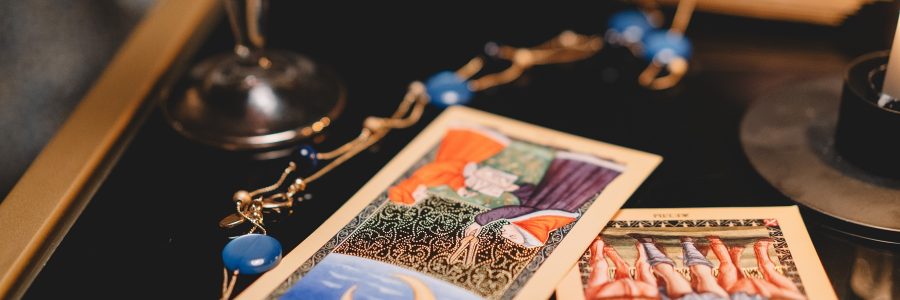The Rider-Waite
This deck should correctly be termed the Waite-Smith Tarot in order to reflect the equal impact both the designer and the illustrator have had on the modern Tarot. Created in 1909 by A.E. Waite and illustrated by Pamela Colman Smith, this was one of the first decks to have a fully illustrated set of suit cards, rather than simply having the number of suit symbols printed on it. Waite was a member of the Hermetic Order of the Golden Dawn, an esoteric brotherhood in search of mystical wisdom and enlightenment, and much of the Golden Dawn symbolism has found its way into the Rider-Waite deck.
For some time, the Rider-Waite was the only Tarot deck widely available in America, leading to the grossly incorrect assumption that it is the oldest or original deck. The familiar yellow backgrounds and distinctive style have made this deck the one most people recognise as “The Tarot”.
Rider Waite Tarot Deck (U.S. Games edition)
Rider Waite Tarot Deck (5 Languages) (U.S. Games edition)
Rider Waite Tarot Deck Giant (U.S. Games edition)
Rider Waite Tarot Deck Golden (U.S. Games edition)
Rider Waite Tarot Deck Miniature Edition (U.S. Games edition)
Rider Waite Tarot Deck Pocket Edition (U.S. Games edition)
Rider Waite Tarot Total Deck Book Set (U.S. Games edition)
The Visconti-Sforza
Variously known in slightly different editions as the Pierpont Morgan Visconti-Sforza, the Visconti Gold, and the Cary-Yale Visconti, this deck is the best example of an early Italian Tarot deck. Originating from 1450s Milan, it is supplemented by a handful of modern recreations of missing cards. The Pierpont Morgan has 74 original cards, while the Cary-Yale has 67 originals. The Cary-Yale has a number of extra cards added throughout the ages (the total number of cards in the set is 86!) including female Knights and Pages in addition to the male sets, and three cards representing Faith, Hope, and Charity.
These cards are large ( 7 ½ inches long and 4 inches wide ) and were produced for the allied ducal families Visconti-Sforza of Milan. The Visconti is the oldest surviving example of a Tarot deck, and shows us just how upper-class the original game must have been. Each deck was hand-painted to order by an artist, usually a well-known artist; they were extremely expensive, often incorporated visages of the family or members of the court. Very Christian in symbolism and medieval in iconography, it is a fascinating piece of history. To actually use it in a modern divination sense is challenging, however, as the symbolism modern readers are used to is practically non-existent in the deck. It can, however, be extremely rewarding, especially if you are seeking to recreate a historical period or wish to cut out all the accumulated symbolism. The Medieval Scapini is a deck based on the Visconti style and iconography, illustrated by Luigi Scapini, the artist who created the replacement cards for the Visconti.
Visconti-Sforza Pierfont Morgan Tarocchi Deck
Marseille
As far as scholars can determine, tarot cards first appeared in northern Italy in the heyday of the Renaissance. Almost every city had their own distinctive version of the tarot. One variation spread to France to become the Tarot de Marseille, the classic tarot that inspired virtually all our present-day decks, occult theories, and divination practices.
The Tarot de Marseille is the French equivalent of the historically significant Visconti. Until recently, the oldest version known to history dated from 1760 and was engraved by Nicolas Conver. (scarabeo)
Traditionally, the Tarot de Marseilles has an unnumbered Fool, and the Death card is unnamed. The art consists of simple line drawings, originating from the fact that the original was an engraved or wood-block print, with very basic limited colours. Swords and Wands can be confusing at first, but swords are curved and wands are not. You can get versions today that are more colorful than their forebears, and you can get reproductions of older versions that look very authentic.
The Marseilles Tarot was redesigned in 1997 by Philippe Camoin (with Alejandro Jodorowsky) after Camoin discovered an older deck dating from 1672, did extensive research and discovered that much of the original artistic details and symbolism had been lost over time.
Minchiate
The earliest example of a Minchiate deck dates from 1725 (scarabeo). Although the Visconti is the earliest Italian example of Tarot, the Minchiate of Florence is arguably the most metaphysically complex variation to be found. The Minchiate expands the system of trumps to include all twelve zodiac signs; the four elements (earth, air, fire and water); and added four more virtues (Prudence, Faith, Hope, and Charity). The Popess (what evolved into the High Priestess) was removed from the trumps. The result was a ninety-seven card deck with a total of forty trumps plus the Fool. The Minchiate uses much mythological and fantastic imagery in its illustration: for example, the mounted Knights are often depicted as centaurs or gryphons.
Like the Visconti decks, this variation is not easy for the modern reader to grasp, what with all the extra cards. The extras can, however, be a rich addition to a reading and add depth to a spread.
